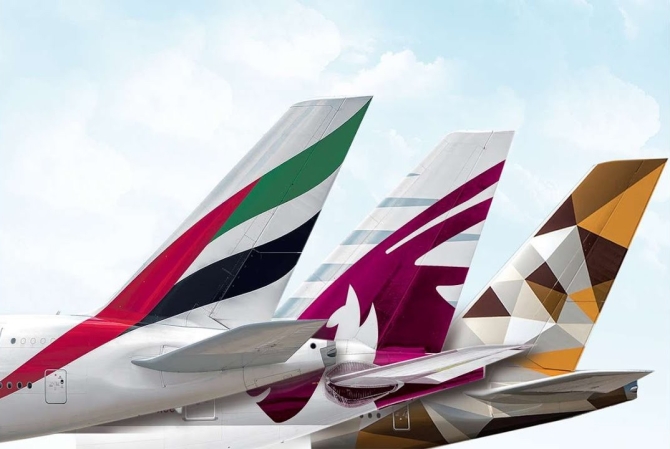Oliver Wyman: Middle East aviation market to see rapid growth over the next decade
Click on image to download high resolution version
Oliver Wyman’s forecast highlighted that the Middle East remains among the fastest-growing aviation markets in the world, with the regional fleet set to expand by 5.1% annually over the next decade.
According to Oliver Wyman’s Global Fleet and MRO Market Forecast 2023-2033, the Middle East aviation market is set to maintain its rapid growth trajectory over the upcoming decade, with the region’s share of the global fleet set to expand, despite a sluggish international travel market.
Market growth
The global management consulting firm revealed that the global commercial fleet currently stands at 27,400 aircraft, nearly 98% of where it was in January 2020. Meanwhile, global passenger traffic stands at 82% of its 2019 level.
Moreover, the global maintenance, repair, and overhaul (MRO) market required to keep the fleet in operation is expected to return to 98% of its 2019 peak by year-end.
Tapping into the Middle East market, the report highlighted that the Middle East remains among the fastest-growing aviation markets in the world, with the regional fleet set to expand by 5.1% annually over the next decade.
Correspondingly, the region’s MRO sector is projected to grow at a compound annual growth rate (CAGR) of 4.9% in the same period.
While the market remains heavily dependent on international travel— which has been slower to recover compared to domestic travel— the Middle East aviation market saw a significant increase in air traffic owing to the FIFA World Cup.
Over and above, Oliver Wyman’s market outlook predicted that the region’s share of the global fleet will grow from 4.9% in 2023 to 6% in 2033, forecasting that the global fleet will expand one-third by 2033, to well over 36,000 aircraft, with a “record number of aircraft deliveries over the next 10 years, despite current supply chain constraints.”
According to the forecast, the anticipated fleet growth will be largely driven by the addition of narrow-bodied aircraft in the next decade, marking a significant shift from widebodies, which have long been the region’s standard.
Narrowbodies will increase to 48% of the fleet from 39%, while widebodies will decline to 48% from 56%.
“The aviation industry has played a very important role in the growth of the Middle East region. The well-established players are continuously revamping their commercial models and operations to be ready for waves of growth,” Oliver Wyman’s Partner and the Head of the Transportation, Services, and Operations Practices, André Martins said, remarking that with new players entering the market, and countries revamping their offerings across the entire value chain, the Middle East aviation industry is expected to continue to gain importance at the global level.
Anticipated headwinds
The market forecast further highlighted a range of emerging challenges set to face the industry over the upcoming decade, from labour shortages to production delays and the accelerated transition to net-zero operations.
According to the firm, talent supply gaps already amount to 18% of the total pilot workforce in 2023 and 14% of aviation mechanics.
Supply chain disruption and higher operating costs continue to cloud growth projections globally, the company revealed, noting that despite the impact of soaring jet fuel prices, aircraft parts rates, and salaries in 2022, global carriers are expected to fully recover in 2023.
Despite improved engine efficiency and the shift from older, less efficient aircraft to newer models, the industry’s greenhouse gas emissions are likely to increase over the next decade, due to the growing demand for air travel and the lack of alternatives to current jet propulsion.
Source: Aviation Business ME

